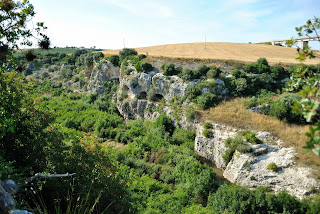Few days ago Katja
from Thalassia invited me by e-mail to the seminar Joy Welcult, to be held on Tuesday 28th
in the Mesagne’s castle.
The Joy Welcult project,
co-funded by the European Union (ERDF) and by National funds of Greece &
Italy, aims to realize an ecomuseum in both the countries.
The Apulian Region has
indicated Mesagne, and its neighbour towns, the area in which the ecomusuem will
be realized.
What is an ecomueum? And why creating an ecomuseum in Mesagne?
The ecomuseum merges cultural heritage and environment.
The goal is to let the
citizens be more aware of their identity.
Therefore,
associations with support of public and private players, are strongly invited
to give their contribute.
In this specific case,
the common background is represented by the Messapian area of Mesagne, Latiano
and other towns (yet to be selected) which share history and traditions.
Damiano Franco (pictured),
president of GAL Terra dei Messapi says: “we wish that Mesagne and Latiano co-operate to develop
the archaeological site of Muro Tenente”.
By the way, Messapia
is a pre-roman civilisation, with Illiric roots.
Mauro Paolo Bruno (pictured), Dirigente ufficio beni Archeologici e Architettonici della regione Puglia, reports: “the National Confederation of Craftsmen (CNA) is leader partner of
the Joy Welcult
project”.
Simonetta Dellomonaco (pictured) states: “According to CETS
and European Landscape Agreement, the landscape is what citizens perceive as
landscape”.
“We’d like you guys to find the name of the ecomuseum” She addresses to the audience.
Within this framework,
booking on-line and e-commerce will be implemented in order to support local
producers to trade their goods and manufactures.
Roberta Lopalco (pictured) points
out: “the Apulian Piano Paesaggistico Regionale is strictly connected to the
Joy Welcult project”.
Apulia is the first Italian region to adopt such a Piano, meant to preserve the Apulian
landscape.
He passionately talks
about the importance of carrying out an ecomuseum in Mesagne, province of
Brindisi.
However, he adds: “Italy still lacks of a national law on ecomuseum”.
I think to myself that this is a shame.
The speakers would
like to continue talking about it, however it’s 1.30 and people begin
to be hungry.
So, after few
audience’s remarks, whom contribute is genuinely invoked by the speakers,
it’s time to have lunch.
I fill my glass of
white wine as well as my dish of bruschetta and pettole.
While eating, I start
a conversation with Paolo, an anthropologist, who works for La Manovella, an
association located in Mesagne.
“You know” he says “I
am a blogger as well”. “Really?” I reply. “Yes, the address is urbanslumsconnection.blogspot.com
While talking with
others who attended the seminar, I discover another blogger. “My name is Jovanka. I feel fulfilled when I focus on my blog ilmiosognodiviaggiare.blogspot.com”. She says.
I am so astonished by
the high number of bloggers.
It’s 2.30.
It’s time to leave.
I feel so merry after
just two glasses of wine…





































